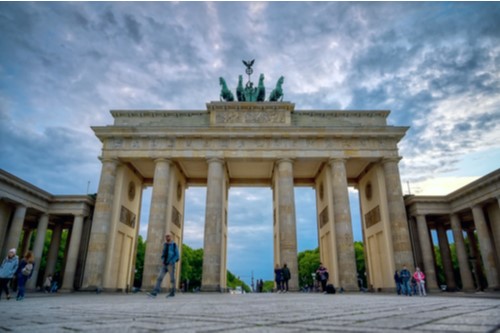- The Berlin Wall came down 30 years ago, signifying the end of the Soviet Union and paving the way for German reunification.
- Today, Nicholas Vardy reflects on the Berlin Wall’s significance and impact on global wealth.
“Mr. Gorbachev, open this gate. Mr. Gorbachev… Mr. Gorbachev, tear down this wall!”
– President Ronald Reagan
On November 9, 1989 – just over 30 years ago – I watched on CNN as thousands of East Germans tore down the Berlin Wall.
It was a historic moment… and the final nail in the coffin of the Soviet Union and its Eastern European empire.
Earlier that year, in August, Hungary raised the “Iron Curtain” – allowing its citizens to travel freely to the West.
Within another two years, even the Soviet Union disappeared from the map.
Berlin: A Historical Primer
I’ve always been a student of history.
And in my “before kids” days, each summer I would do a bike ride through a historic part of Europe.
In July of 2013, I cycled 100 miles on a path that runs along what was once the Berlin Wall.
Every few kilometers, there would be a memorial describing how one East German teenage soldier shot and killed another East German teenager as he tried to escape to the West.
The absurdity of it all boggles my mind.
During the Cold War, Berlin always held a special place in the American psyche.
Berlin was where President John F. Kennedy declared “Ich bin ein Berliner” in 1963.
President Ronald Reagan gave an equally important speech at the foot of Berlin’s Brandenburg Gate in 1987, calling on Mikhail Gorbachev, general secretary of the Communist Party of the Soviet Union, to “tear down this wall.”
With a population of 3.75 million people today, Berlin is Germany’s largest city.
In recent years, Berlin has leapfrogged over Paris, Rome and Madrid to become the second-largest city in the European Union.
If Britain exits the EU, Berlin will become the largest city in the EU. In doing so, Berlin will have recaptured its historically prominent position.
Had you seen the city on the eve of World War I in 1914… you’d have found that if London was Europe’s New York City, then Berlin was Europe’s Chicago.
Berlin always had an upstart’s chip on its shoulder. Even Kaiser Wilhelm II asked in 1892, “Berlin is a great city, a world city (perhaps?).”
Within a few decades of German unification in 1871, Berlin became a global leader in industry and science.
In 1901, the first Nobel Prize for medicine was won by a Berliner, Emil von Behring, for his serum against diphtheria.
Einstein’s general theory of relativity, Planck’s quantum mechanics and Heisenberg’s uncertainty principle all emerged from Berlin. So did the spectroscope, the discovery of radio waves and a cure for syphilis.
By the 1930s, the University of Berlin and its medical faculty had won 29 Nobel Prizes.
Many of these academics were Jewish, later chased out by the Nazis.
The next generation of Nobel Prizes went to the United States in a migration dubbed by some historians as “Hitler’s gift.”
Berlin: After the Wall and Beyond
After World War II, the Allies divided Berlin into four sectors: American, British, French and Soviet.
Overnight, on August 13, 1961, the East German government ordered the construction of the Berlin Wall. And East Berlin was born.
Between 1945 and 1961, 3.5 million East Germans fled to West Berlin – escaping the Eastern Bloc.
Between 1961 and 1989 – the year the Berlin Wall fell – at least 136 East Germans died trying to flee.
The collapse of the Berlin Wall changed all that. And Berlin entered a period of rebirth.
Today, Berlin does not have the global gravitas of London or the romantic attractions of Paris. After all, Berlin was razed by bombing raids during World War II.
And you have to look long and hard to find any real hard evidence of Hitler’s “thousand-year Reich” today. The site of Hitler’s bunker lies unmarked, 40 feet below ground in an anonymous parking lot.
How do the two sides of Berlin compare today?
Along the former Berlin Wall, it is hard to tell East from West.
But go a bit farther into what was then the East, and the architecture is still vintage Eastern Europe block housing. The area that was West Berlin is like Zurich, Switzerland, but that of East Berlin is like Warsaw, Poland.
A Lesson in Soft Power
When in Berlin, I saw two massive monuments for the Soviet soldiers who liberated Berlin from the Nazis. One was the Soviet War Memorial in Treptower Park, and the other was the Soviet War Memorial in Tiergarten.
Alas, I saw no monuments dedicated to the Western Allies, even though they kept the West side of the city free for more than 45 years.
Berlin’s left-wing government has been reluctant to offer more than a small memorial plaque to commemorate Reagan’s famous 1987 speech.
But today, a statue of “the Gipper” stands on the balcony of the American Embassy overlooking the site of Reagan’s speech.
How did it get there despite so much political opposition? The statue stands on American soil. It did not require the approval of the local Berlin government.
Still, my favorite example of the United States’ soft power (an approach to international relations that uses persuasion rather than coercion) is this…
When I visited “Checkpoint Charlie” – the infamous border crossing between East and West Berlin – I was greeted by both a McDonald’s and a Starbucks.
The verdict of history is clear… In the end, McDonald’s trumped Marx and Starbucks thumped Stalin.
And Berliners have the United States and the Allies to thank for that.
Good investing,
Nicholas
P.S. Both the Berlin speeches of Kennedy and Reagan are impressive. It’s remarkable how members of rival political parties struck such a similar tone 25 years apart.
Interested in hearing more from Nicholas? Follow @NickVardy on Twitter.
